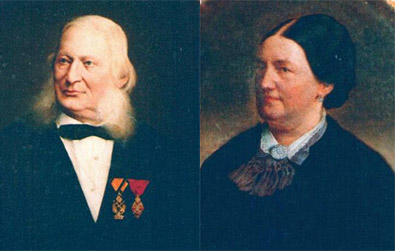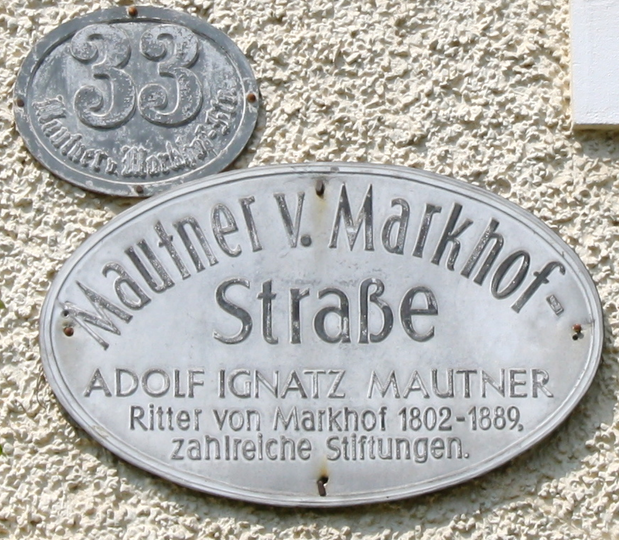Adolf Ignaz Mautner / 26.12.1801 – 24.12.1889
Born in Smiřice (Smiřitz, Czech Republic), after an exemplary career and his merits in 1872, he was awarded the noble title of Ritter von Markhof. In June 1831, he married Julie Marcelline Kadich, their marriage produced ten children.
Entrepreneurial success
In 1840, he moved to the Habsburg residence town and one year later began his exemplary career with the lease of the run-down brewery St. Marx on the Landstraßer Hauptstraße 173 – 175. Very quickly he prevailed against the overpowering competition of Dreher by being the first to produce year-round bottom-fermented beer, the so-called “Abzugsbier” (drawn off from the fermenting vats in storage barrels to complete the fermentation process). His main objectives were to improve the quality of this good beer, which until then could only be brewed in the cool season, and to deliver it when it was needed most, in summer. Initially, in the first quarter of the year he brewed over and above demand, storing the extracted stock in ice cellars and delivering it in April. However, this beer was not suitable for longer storage, and the investments for very large storage cellars were too high. The alternative, however, was to brew bottom-fermented throughout the summer. As early as 1843, the technically innovative brewery specialist therefore developed cooling devices with pipe systems through which water was fed with ice pieces and ice floats in the fermenting vats. He also created a new type of storage room, the “normal beer storage cellar system Mautner”, whose ice cooling made it possible to serve cool beer during the hot season. This considerable increase in production finally secured his reputation and the reputation of his brewery. He won the landlords for his product by offering them a ready, yeast-free “Abzugsbier”.
Through rationalization measures, multiple extensions, the construction of a malt house and brewery in Göding (Moravia) and the use of a steam engine from 1845 onwards, the production figures were constantly increased (in 1840 36,000 hl and in 1876 already 267,000 hl were produced).
Adolf Ignaz also ensured the success of his company with other products. Yeast, previously obtained from the top-fermented brewing process and then used for the production of white biscuits, had become a scarce commodity. Together with his son-in-law, the Graz brewer Johann Peter Reininghaus and his brother, the chemist Julius, he developed the “Wiener Abschöpfverfahren” (method to skim off beer) in 1847 for the production of high-quality baker’s yeast, which went into production in 1850.
This led to a stimulation of the export of Hungarian flour to Western Europe, whose sticky varieties were only suitable for “white bakeries” after the addition of compressed yeast. The development of the industrial production of compressed yeast, for which he not only won a prize awarded by the Viennese Bakers’ Guild and was awarded the Gold Medal of the Lower Austrian Trade Association, but also the process of which was subsequently accepted worldwide, finally secured his breakthrough and was at the same time a milestone in his life’s work.
In 1857, the successful entrepreneur bought the entire complex in St. Marx, including the former supply house, gardens and fields, for 275,000 guilders. When the St. Marx factory was no longer sufficient, he set up similar businesses in Floridsdorf (1864) and Simmering. At this time, the brewery was the third largest in Europe. In 1876, he handed over the Simmering brewery to his son Carl Ferdinand Mautner von Markhof, in the meantime ennobled, while the Floridsdorf brewery St. Georg had been managed by his son Georg Heinrich Mautner von Markhof since its foundation.
Adolf Ignaz had finally become a business tycoon. In addition to his production facilities in St. Marx, Simmering, Floridsdorf and the malt house in Hodonín, he also owned a flax spinning mill in Opava and a lead, silver and copper mine in Tergowe on the Bosnian military border with the Ottoman Empire since 1872.
Humanitarian work
After handing over the management to his son Carl Ferdinand, he devoted himself to welfare and the foundation of numerous charitable institutions until the end of his life. During the wars of 1859, 1864 and 1866, for example, he built military hospitals in his companies and in 1875, together with his wife Julie Marcelline, donated the Crown Prince Rudolf Children’s Hospital (from 1921 Mautner Markhof’s Children’s Hospital). He transformed his birthplace in Smiřice into a supply house for old, destitute citizens, and in Baden near Vienna he built a kindergarten with a food outlet for poor schoolchildren. He also financed several orphanages and old people’s homes throughout Austria and orphanages in Vienna and Baden.
Awards and Honours
- 1848 Presidency of the Brewers Union for Vienna and the surrounding area
- 1850 Prize of the Viennese Bakers’ Guild
- 1862 Gold Salvatore Medal (double)
- 1867 Knight’s Cross of the Order of Franz Joseph
- 1872 Order of the Iron Crown III Class
- 1872 raised to the nobility to Ritter Mautner von Markhof
- 1879 Honorary citizen of Smiřitz, Baden and Göding
- 1881 Honorary citizenship of Vienna
- Honorary citizen of Bořitz
- 1890 Markhofgasse (3rd district Vienna)
- Mautner-von-Markhof-Straße (Baden b. Vienna)
- Gold medal of the Lower Austrian Trade Association
Adolf Ignaz Ritter Mautner von Markhof was buried in an arcade crypt designed by Carl Kundmann at the Vienna Central Cemetery. Magnificent reliefs on his tomb still remind us today of three of his greatest benefactions: the foundation of an orphanage, old people’s home and children’s hospital.
Stations in the life of Adolf Ignaz Ritter Mautner von Markhof
| 1801 – 1829 | Adolf Ignaz was born in Smiřice/Bohemia on December 26th, 1801 as the offspring of a long-established brewing family. |
| 1830 | On April 14th, his father died at the age of 68 and Adolf Ignaz took over the family business, an already relatively large firm. |
| 1831 | On June 27th, he married Julie Marcelline Kadich, born on February 6th, 1812 in Senftenberg/Bohemia, who would give him four sons and six daughters. |
| 1840 | Adolf Ignaz moves to Vienna with his family and rents the St. Marx brewery. In order to prevail against the overwhelming competition of the Dreher’s brewery in Klein-Schwechat, he decides to produce bottom-fermented, so-called “Abzugsbier”, which he draws from the fermentation vats into storage barrels, in which the fermentation process is ended. This saves the innkeepers from having to ferment in their cellars and he succeeds as well in keeping the beer stable until May. |
| 1842 | Adolf Ignaz invents an ice cooler. |
| 1843 | This year, for the first time, he succeeded in producing high-quality draft beer throughout the summer and he developed his own storage room type, the “normal beer storage cellar system Mautner”. Both ensure the excellent reputation of his brewery. |
| 1845 | The production figures are steadily increasing through multiple additional developments and the use of a steam engine. A malthouse and brewery are built in Göding/Moravia. |
| 1846 | Compressed yeast, the quality of which is not yet entirely satisfactory, is produced. He secured the collaboration of the young Westphalian chemist Reininghaus, who had knowledge of artificial yeast production. |
| 1846 – 1847 | Adolf Ignaz is head of the Vienna Brewery Guild. |
| 1848 | Adolf Ignaz is largely responsible for social peace during the revolution. |
| 1850 | The “Viennese Process”, his breakthrough in baker’s yeast production, is awarded a prize. |
| 1853 | The first iron reservoirs for the fireproof storage of alcohol are installed. |
| 1857 | Adolf Ignaz acquires the brewery, tavern, bakery, smithy, supply house, gardens and fields in St. Marx for 275,000 guilders. |
| 1858 | His eldest son Carl Ferdinand becomes a partner and the establishment, which also includes an alcohol distillery that recycles brewery waste, is now called Maunter & Sohn. New buyers for the raw alcohol will be found in the Viennese liqueur producers. |
| 1862 | Adolf Ignaz receives the large gold Salvatore Medal. |
| 1859, 1864, 1866 and 1872 | During these war years, he had military hospitals built. |
| 1867 | Adolf Ignaz receives the Knight’s Cross of the Order of Franz Joseph. |
| 1871 | Adolf Ignaz proves himself to be a pioneer of social reforms in the brewery industry. |
| 1872 | On May 14th, Adolf Ignaz was ennobled and raised to the Austrian nobility with the title “von Markhof” – he was awarded the Order of the Iron Crown III. Class. Adolf Ignaz and Julie Marcelline donate the children’s hospital in Vienna’s 3rd district. |
| 1873 | Emperor Franz Joseph I visits Adolf Ignaz in his pavilion at the Vienna World Exhibition. |
| 1876 | Adolf Ignaz retires from his business to his house at Franziskanerplatz 1 and hands everything over to Carl Ferdinand, with the exception of the Floridsdorf business, which his third eldest son Georg Heinrich has managed from the start. From then on Adolf Ignaz devoted himself only to charity. |
| 1881 | On June 24th, the City of Vienna granted him honorary citizenship. On June 27th he celebrates with Julie Marcelline their golden wedding anniversary at the “Harter Castle” of his eldest daughter Therese von Reininghaus. |
| 1886 | Adolf Ignaz celebrates his 85th birthday. As every year, the celebration then takes place on February 6th, the birthday of his wife Julie Marcelline. |
| 1887 | His daughter Emilie dies on March 28th at the age of 49 and on April 20th his wife Julie Marcelline dies at the age of 76. Adolf Ignaz dedicates the foundation for orphan girls in Vienna to Julie and at the same time donates one for orphan boys in his own name. He donates his parental home to his hometown Smiřice and turns it into a poor house with a kindergarten. In memory of Emilie Reininghaus, he is setting up a soup kitchen for children in Graz. |
| 1889 | On November 15th, the Mautner von Markhof Foundation to feed poor school children goes into operation in Baden. On December 24th, Adolf Ignaz closes his eyes forever and is buried in the famous arcade crypt of Vienna Central Cemetery. |








